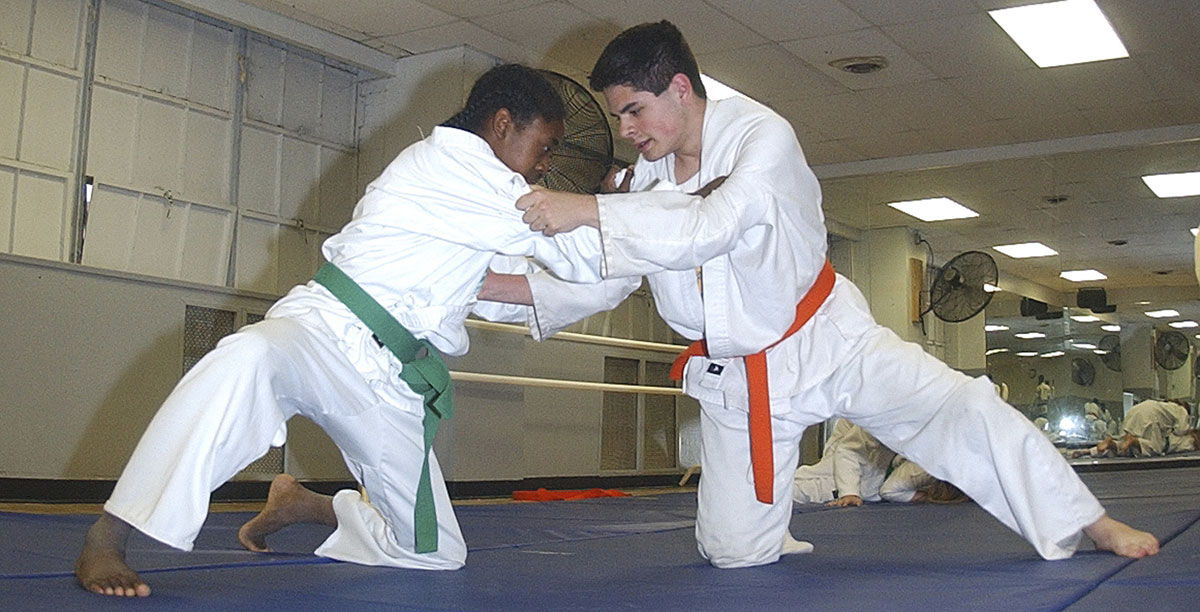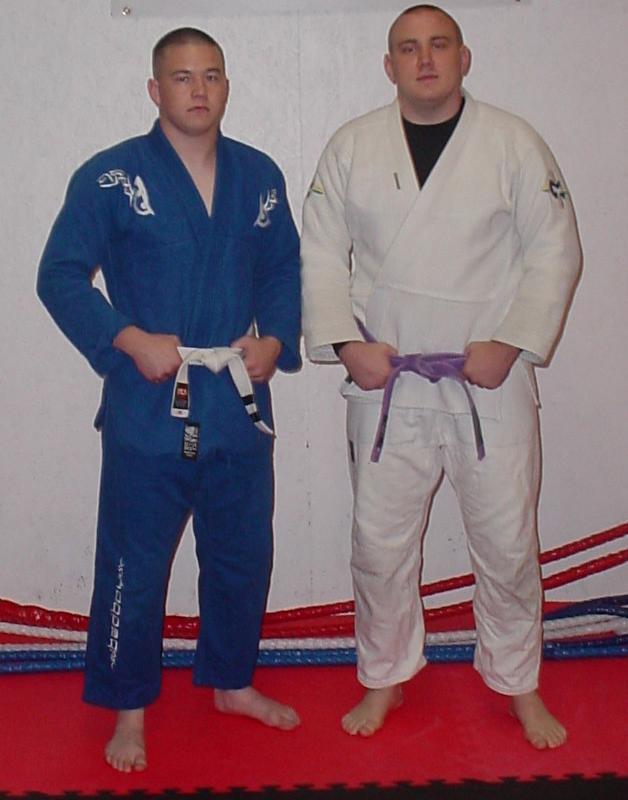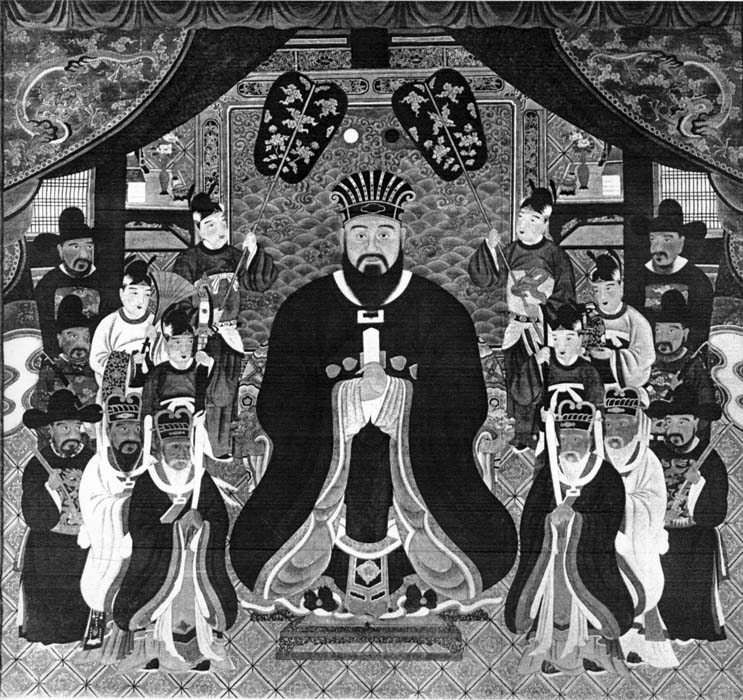|
Keikogi
(, 'practice', , 'dress' or 'clothes'), also known as or , is a traditional uniform worn for training in Japanese martial arts and their derivatives. Emerging in the late 19th century, the was developed by judo founder Kanō Jigorō. Origin Japanese martial arts historian Dave Lowry speculates that Kanō derived the uniform's design from the uniforms of Japanese firefighters' heavy hemp jackets, . By 1920, the as it exists today was worn by Kanō's students for judo practice; a photo displayed in the Kodokan (judo headquarters) taken in 1920 shows Kanō himself wearing a modern . Until the 1920s, Okinawan karate practice was usually performed in everyday clothes. Given the social climate between the Japanese and Okinawans during this time, karate was seen as brutish compared to Japanese martial arts, which had their roots in samurai culture, such as jujutsu. To help market karate to the Japanese, Gichin Funakoshi – the founder of Shotokan karate and the instructor respon ... [...More Info...] [...Related Items...] OR: [Wikipedia] [Google] [Baidu] |
Uwagi
Outside of Japan, an ''uwagi'' (上着/上衣) means a kimono-like jacket worn in Japan. It is believed as most familiar as the top half of a martial arts uniform. The third element, the Obi (sash), obi, ties the uwagi closed. In some martial arts, the set is completed with hakama, which might be worn over, or instead of the Keikogi#Construction, zubon. In the common and modern use of Japanese language, however, "uwagi" just means an List of outerwear, outerwear or tops. See also *''Keikogi'' *''Shitagi'' References External links "How to Fold Uwagi and Hakama" Japanese upper-body garments Japanese martial arts equipment {{clothing-stub ... [...More Info...] [...Related Items...] OR: [Wikipedia] [Google] [Baidu] |
Karategi
''Karate gi'' (空手着 or 空手衣), also called keikogi or dogi, is the formal Japanese name for the traditional uniform used for Karate practice and competition. Description A karategi is somewhat similar to a judogi (柔道着 or 柔道衣, ''Judo uniform'') as it shares a common origin; however, the material and cut of the uniform is generally much lighter and looser fitting. The heaviest of Karategi is only compared to some judogi at . Because of the nature of Karate training which emphasizes striking, kicking, and a more limited range of standing throws compared to Judo the karategi has evolved in a manner that maximizes mobility and speed without the extremely coarse and strong fabric required for grappling and throwing found in Judo. They are made from smooth cotton which may be brushed or ribbed for unrestricted movement and added comfort. Reinforced stitching is common, as to compensate for the stresses put on the gi. Inferior karategi are often cut from a light fa ... [...More Info...] [...Related Items...] OR: [Wikipedia] [Google] [Baidu] |
Judogi
''Judogi'' (柔道着 or 柔道衣), also called keikogi or dogi, is the formal Japanese language, Japanese name for the traditional uniform used for Judo practice and competition. A judogi is somewhat similar to a karategi (空手着 or 空手衣, "karate uniform") as it shares a common origin. Jigoro Kano derived the original judogi from the kimono and other Japanese garments around the turn of the 20th century, and, as such, the judogi was the first modern martial arts training uniform. Over the years, the sleeves and pants have been lengthened, the material and fit have changed, the traditional unbleached cotton is now a bleached white, and blue judogi has become available; nevertheless, the uniform is still very close to that used 100 years ago. Other martial arts, notably karate, later adopted the style of training uniform that is used in Judo. A judogi comprises three parts that are usually cut from different fabrics: a very heavy jacket (uwagi), lighter canvas pants (shit ... [...More Info...] [...Related Items...] OR: [Wikipedia] [Google] [Baidu] |
Brazilian Jiu-Jitsu Gi
The Brazilian jiu-jitsu gi is the training uniform adapted from the judo ''keikogi'' (wikt:稽, 稽wikt:古, 古wikt:着, 着) for use in Brazilian jiu-jitsu. A ''gi'' (wikt:着, 着), meaning dress or clothes, is composed of a heavy cotton jacket, reinforced drawstring pants, and a belt which communicates Brazilian jiu-jitsu ranking system, rank. Some schools require the jacket and trousers to be the same color, while more relaxed schools do not enforce matching top and bottom color. The Brazilian jiu-jitsu gi is often referred to as ''kimono'' by Brazilians. Some Jiu-Jitsu schools avoid using a gi and instead focus on no-gi jiu-jitsu; 10th Planet Jiu Jitsu is an example of this. General regulations The only colors allowed for international championships are white, black or blue. In some jurisdictions, this is relaxed to allow any single solid color. According to article 8 of International Brazilian Jiu-Jitsu Federation, IBJJF rules, a competition gi must conform to the ... [...More Info...] [...Related Items...] OR: [Wikipedia] [Google] [Baidu] |
Hakama
are a type of traditional Japanese clothing. Originally stemming from Ku (), the trousers worn by members of the Chinese imperial court in the Sui and Tang dynasties, this style was adopted by the Japanese in the form of in the 6th century. are tied at the waist and fall approximately to the ankles. They are worn over a kimono specially adapted for wearing , known as a . There are two types of : divided and undivided . The type have divided legs, similar to trousers. Both of these types appear similar. A "mountain" or "field" type of was traditionally worn by field or forest workers. They are looser in the waist and narrower in the leg. are secured by four straps (): two longer attached on either side of the front of the garment, and two shorter attached on either side of the rear. The rear of the garment may have a rigid trapezoidal section, called a . Below that on the inside, there may be a (a spoon-shaped component sometimes referred to as a ) which is ... [...More Info...] [...Related Items...] OR: [Wikipedia] [Google] [Baidu] |
Dobok
() is the uniform worn by practitioners of Korean martial arts, such as taekwondo. means "way" and means "clothing". The came from the Japanese ''keikogi/dōgi'', used in Japanese martial arts, such as judo. The comes in many colors, though white and black are the most common. The may have the reverse in a different colour than the rest of the . They are made in a variety of materials, ranging from traditional cotton to cotton-polyester blends. The pants and sleeves of the are wider and longer than the traditional Japanese . Due to this, practitioners often wear a modeled after the Korean . The of World Taekwondo Federation-style taekwondo practitioners usually have v-neck jackets, tailored after the design of the hanbok. Traditional taekwondo practitioners may wear that are identical or very similar to , with a cross-over jacket front, while International Taekwon-Do Federation-style taekwondo practitioners typically wear a newer design with a vertically closing jac ... [...More Info...] [...Related Items...] OR: [Wikipedia] [Google] [Baidu] |
Obi (sash)
An is a belt of varying size and shape worn with both kimono, traditional Japanese clothing and keikogi, uniforms for budō, Japanese martial arts styles. Originating as a simple thin belt in Heian period Japan, the developed over time into a belt with a number of different varieties, with a number of different sizes and proportions, lengths, and methods of tying. The , which once did not differ significantly in appearance between men and women, also developed into a greater variety of styles for women than for men. Despite the kimono having been at one point and continuing to appear to be held shut by the , many modern are too wide and stiff to function in this way, with a series of ties known as , worn underneath the , used to keep the kimono closed instead. are categorised by their design, formality, material, and use, and can be made of a number of types of fabric, with heavy brocade weaves worn for formal occasions, and some lightweight silk worn for informal occasions ... [...More Info...] [...Related Items...] OR: [Wikipedia] [Google] [Baidu] |
Shotokan
is a style of karate, developed from various martial arts by Gichin Funakoshi (1868–1957) and his son Gigo (Yoshitaka) Funakoshi (1906–1945). Gichin Funakoshi was born in Okinawa and is widely credited with popularizing "karate do" through a series of public demonstrations, and by promoting the development of university karate clubs, including those at Keio, Waseda, Hitotsubashi (Shodai), Takushoku, Chuo, Gakushuin, and Hosei. Funakoshi had many students at the university clubs and outside dojos, who continued to teach karate after his death in 1957. However, internal disagreements (in particular the notion that competition is contrary to the essence of karate) led to the creation of different organisations—including an initial split between the Japan Karate Association (headed by Masatoshi Nakayama) and the Shotokai (headed by Motonobu Hironishi and Shigeru Egami), followed by many others—so that today there is no single "Shotokan school", although they a ... [...More Info...] [...Related Items...] OR: [Wikipedia] [Google] [Baidu] |
Kendo
is a modern Japanese martial art, descended from kenjutsu (one of the old Japanese martial arts, swordsmanship), that uses bamboo swords ( shinai) as well as protective armor ( bōgu). It began as samurai warriors' customary swordsmanship exercises, and today, it is widely practiced within Japan and has spread to many other nations across the world. History Swordsmen in Japan established schools of ''kenjutsu'' (the ancestor of kendo). These continued for centuries and form the basis of kendo practice today.. Formal kendo exercises known as ''kata'' were developed several centuries ago as ''kenjutsu'' practice for warriors. They are still studied today, in a modified form. The introduction of bamboo practice swords and armor to sword training is attributed to during the Shotoku Era (1711–1715). Naganuma developed the use of this armor and established a training method using bamboo swords. , third son of Naganuma and the eighth headmaster of the Kashima Shinden Jik ... [...More Info...] [...Related Items...] OR: [Wikipedia] [Google] [Baidu] |
Karate
(; ; Okinawan language, Okinawan pronunciation: ), also , is a martial arts, martial art developed in the Ryukyu Kingdom. It developed from the Okinawan martial arts, indigenous Ryukyuan martial arts (called , "hand"; ''tī'' in Okinawan) under the influence of Chinese martial arts. While modern karate is primarily a striking art that uses punches and kicks, traditional karate training also employs Throw (grappling), throwing and joint locking techniques. A karate practitioner is called a . Beginning in the 1300s, early Chinese martial arts, Chinese martial artists brought their techniques to Okinawa. Despite the Ryukyu Kingdom being turned into a puppet state by Japanese samurai in 1609, after the Invasion of Ryukyu, its cultural ties to China remained strong. Since Ryukyuans were banned from carrying swords under samurai rule, groups of young aristocrats created unarmed combat methods as a form of resistance, combining Chinese and local styles of martial arts. Training emph ... [...More Info...] [...Related Items...] OR: [Wikipedia] [Google] [Baidu] |
Korean Martial Arts
Korean martial arts ( or ) are fighting practices and methods which have their place in the history of Korea but have been adapted for use by both military and non-military personnel as a method of personal growth or recreation. The history of Korean martial arts can be traced as far back as the prehistoric era. Notable examples of unarmed martial arts include taekwondo, hapkido, ssireum, and taekkyon. For armed martial arts, Korean archery, Kumdo, Korean swordsmanship, and knife fighting exist. In November 2011, taekkyon was placed on the UNESCO Intangible Cultural Heritage of Humanity List. History Early history Wrestling, called ssireum, is the oldest form of ground fighting in Korea, while Subak was the upright martial art of foot soldiers. Weapons were an extension of those unarmed skills. Besides being used to train soldiers, both of these traditional martial arts were also popular among villagers during festivals for dance, mask, acrobatic, and sport fighting. ... [...More Info...] [...Related Items...] OR: [Wikipedia] [Google] [Baidu] |








